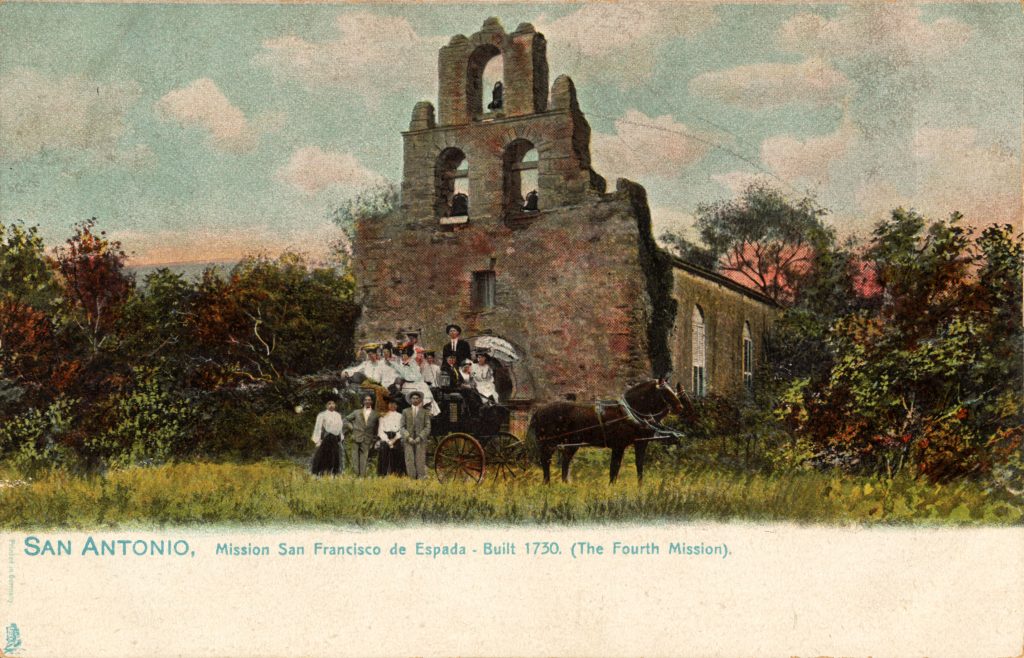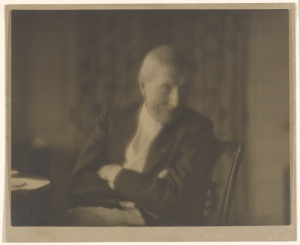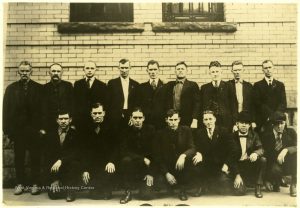Have you ever heard the story about the old spirit that walks the walls of the old ruins at night? They say he waves a lantern back and forth to guide people across the San Antonio River at night. The walls are gone now, and few people walk through the river anymore. Hidden among a dense forest of oak and mesquite trees, and behind a bunch of cattle, under a lot of sand, are the ruins of a part of history that helped make Texas the great cowboy and cattle capital that is today.
Now imagine growing up, hearing stories told by older generations of a lost ranch outpost that was once part of Mission Espada in San Antonio, hidden among the brush. Stories of a ranch that was vital not only to the culture of the past but also to present-day South Texas. Legends of tunnels leading to the San Antonio River and lost treasure have been passed around in hopes of one day finding the locations. This place has many names, but locals know it as Rancho de Las Cabras. Today, Rancho de las Cabras is located off State Highway 97, outside a small town named Floresville in Wilson County.
In 1731, a group of colonists from the Canary Islands off the Iberian Peninsula settled the Villa de San Fernando de Bejar, which would later be called San Antonio.1 Rancho de las Cabras opened as a mission post around 1731 when the Canary Islanders complained of the mission’s cattle trampling and ruining their land. There were many livestock according to a report from 1745: 1,150 cattle, 750 sheep, 90 goats, and 30 horses and oxen. The friars of the mission moved the animals 30 miles southeast of what would be known as “Mision de Las Cabras” (or Rancho De Las Cabras). The highly successful mission outpost provided Mission Espada with a surplus of meat. 2
Rancho de las Cabras served as a mission outpost for the San Francisco Mission Espada, which is about 30 miles north. Both missions were on the San Antonio River, which played a vital role in shaping Texas. The ranch was run by missionaries and colonized Native Americans, who were believed not to have been native to the San Antonio area, beginning in 1731.3 The headquarters was built between 1758 and 1762. Those who lived in the outpost fell victim to constant raids by the Lipan Apaches and other raiders because it was far from the protection provided by soldiers from the Presidio San Antonio De Bejar’s.4
Historians credit Rancho de Las Cabras as the birthplace of the Cowboy culture (vaqueros). The outpost’s success with livestock is why Texas has a large cattle ranching industry today.5 Locals pride themselves on this contribution to the state’s identity and economy. Wilson and Atascosa Counties have an ongoing debate about the being the original “Home of the First Cowboy.” One of the towns in Atascoca County even has a museum dedicated to its history.
Rancho de las Cabras began to decline in the late 1700s, first with attacks from the Lipan Apches. Then, during the late 1700s and early 1800s, the missions were secularized. With this change, all of the unbranded cattle became property of the crown of Spain, and the vast herds number dwindled. A descendant of the Canary Islanders, Ygnacio Francisco Xavier Calvillo, acquired the ranch. When Ygnacio was killed by his grandson, his eldest daughter, Maria Del Carmen Calvillo, gained ownership and control of the property. Calvillo left behind a great legacy of her own success at the ranch. She was known for her “independent spirit,” and she frequently defied the social norms of Spanish and Mexican society. She traded meat from her ranch with local Native Americans to relieve some of the tensions between the two groups. She maintained control of the land until she passed away in 1856. After Calvillo’s death, the land went to two of her children. What became of the ranch slowly faded from the local memory.6

Little is known about what occurred during the time period of the lost and forgotten mission outpost. However, it is an even greater mystery why this once important piece of land was forgotten by the locals who lived around it. The question of how and why it was forgotten is something the Wilson County Historical Society seeks to answer, which now takes great pride in the restoration and conservation of Rancho de Las Cabras by bringing it forth into the memory of the county once again.
In the early to mid 1930s, there was a reemergence of memories about Rancho de las Cabras. According to Gene Maeckle, once mayor of Poth, Texas, Judge Stevenson of Wilson County encouraged people to pick up stones from the site to remember the history of the area. Maeckle explains that Judge Stevenson also ordered for the stones to be used for the construction of a bridge abutment near Rancho de Las Cabras and a smokehouse for personal uses. There is a story about the hidden ancient settlement amongst the brush found in a Wilson County Newspaper in 1934. Just two years later, a monument was erected in honor of the mission outpost, but historians have noted that there is incorrect information and misspelling (“Mission of Las Cabreras”) on the gray protruding slab.
Little information about the site exists again until the 1970s. In 1970, the State Historical Survey Committee erected another sign in honor of the site, including information about the ranch after it was secularized. People again began recalling different stories and experiences of Rancho de Las Cabras, from playing there as a child, going there with the Scouts, camping with the Civilian Conservation Corps (CCC) or just trying to enjoy a hike while looking for the alleged tunnel and Spanish treasure. In 1973, the Texas Historical Commission certified that Rancho De Las Cabras in the National Register of Historic Places. The University of Texas at San Antonio began conducting archaeological surveys and excavations that are still occurring today. During this time, conversations about the site becoming part of the National Park Services were up for debate.7
The National Park Service then acquired a small section of Rancho de las Cabras that had a piece of the ruins on it in 1995. Tours started in the late 1990s, which is also when people realized they had taken stones that did not rightfully belong to them. On the tours, you can see piles of guilty consciences that grew in the middle of the night. No one knows for certain how the piles increase or who is returning piles of the original rocks once taken. Maybe the old spirit is guiding those guilty consciences back to the place where the rocks belong. Around 2011, talk of the San Antonio Missions and outposts began to be inducted into the UNESCO World Heritage Site list.
In 2019, the site receives funding from the government and has plans for a new roadway into the park, parking lot, and interpretive visitor’s center. The road has been paved, but there is not yet a visitor’s center. UTSA’s archaeological team began opening up excavations for the public to participate in. Broken pottery, jewelry, and buttons are just some of the interesting things amateur and professional archeologists have uncovered there. This was a very big deal for Wilson County because it could generate around 56 jobs by 2016, and there was a $4.8 million proposal to go towards the ranch. In July 2015, Rancho de las Cabras became part of the list of UNESCO World Heritage sites, along with the other missions in San Antonio.8 Around the same time, a story emerged in the Wilson County News about the old “Floresville Grammar School” being torn down. The narrator of the story tells the connection to the school, as it was a place they attended and thought it was awful that they were tearing down the walls and she wanted a piece of history. However it turns out these pieces of rock belonged to Rancho De Las Cabras.9

Today, one can take the state highway and pass ranches, the county convention center, the city park, and catch a glimpse of the Promise Land Dairy on the way to the site. The site is not open to the public unless there are events taking place which you can find on the SA National Parks Service events Facebook page.
Multiple buildings in the Floresville area still have rocks from Las Cabras within their constructions, such as the Wiseman-Bump House, that can be seen today. With Rancho de las Cabras, we can see the rise and fall of how people remember a historical site, as well as the changing importance it held to the community. It is important to maintain memory and pass the information to the younger generations. Stories provide a testament to local memory, whether true or not. Story-telling preserves the memory of local histories. So those local legends you always hear? Or the elders of the town rambling about something that used to be that could be found in your local area? Maybe there is some truth to them and should not be completely disregarded. There is a large lesson to be learned with the mission outposts and it is clear that there is still much work to be done to find even more answers about the mission outpost. Memory is important not only to communities but also historians. Local historians are always needed.
- Handbook of Texas Online, “Canary Islanders,” accessed May 03, 2019, http://www.tshaonline.org/handbook/online/articles/poc01. ↵
- Clint E. Davis, “San Francisco de la Espada,” June 15, 2010, https://tshaonline.org/handbook/online/articles/uqs12. ↵
- Christopher Long, “Rancho de las Cabras Historical Site,” June 15, 2010, https://tshaonline.org/handbook/online/articles/ghr01. ↵
- Christopher Long, “Rancho de las Cabras Historical Site,” June 15, 2010, https://tshaonline.org/handbook/online/articles/ghr01. ↵
- Anne A. Fox, “The Indians at Rancho de Las Cabras,” Columbian Consequences Volume 1: Archaeological and Historical Perspectives on the Spanish Borderlands West, 1989, 259–267. ↵
- John T. Becker et al., Texas Women and Ranching: On the Range, at the Rodeo, and in Their Communities (College Station: Texas A&M University Press, 2019), 9-24. ↵
- Gilbert R. Cruz, “San Antonio Missions National Historical Park” June 15, 2010,ne.org/handbook/online/articles/gks06. ↵
- Gregory Ripps, “Rancho de Las Cabras Achieves World Status,” Wilson County News, July 8, 2015. ↵
- Rudy Elizondo, “Reminiscing: Rancho de Las Cabras,” Wilson County News, 2011. ↵



11 comments
Albert Seguin Gonzales
Whatever happen to Don Erasmo’s “Casa Blanca”? Other than the stone marker on 281 on the outskirts or Floresville is the only evidence that it ever existed. Can you please enlighten the public who are thirsty for more history of in and around that area.
Thank you,
Shine Trabucco
Hi Albert,
I am currently working on documenting this house in my PhD dissertation. The foundation of the home remains but I have been recently told the house has been destroyed. And what remains in not the original structure. Thank you for your interest!
Nancy de la Zerda
Excellent article. Well documented information regarding a treasure in our midst that has been deemed a World Heritage Landmark. Our hopes are that history enthusiasts everywhere learn the stories inspired by el Rancho de las Cabras and share them for posterity. The spirit of Doña María del Calvillo lives on. Thank you, Shine Trabucco, for shining a bright light on el Rancho de las Cabras!
Raul Colunga
Great article, I had never heard of Rancho de las Cabras but it was surprising to read that it had so much history. Not only was it the source of the cattle industry, but it was also the start of the cowboy culture. As someone born and raised in San Antonio, there is always something new to learn about this unique city.
Clemente Guzman
Hello, my name is Clemente Guzman. I have been working on my family genealogy for many years. I just found an ancestry that was born in El Rancho de Las Cabras 1772, but the actual archive is from Galeana, Nuevo Leon, Mexico. I did research and didn’t find any place named like that around Galena, the only Ranch de Las Cabras that appear is the one in Texas. I’m looking for more information.
Pablo Ruiz
Being raised in San Antonio Texas I have heard about many other missions but not the Rancho de las Cabras. Reading this article taught me how the cowboys started in such a small place. I really enjoyed this article in how it talks about history from the city i grew up in. It does a good job describing where cowboys came from and is overall well put together.
Paul Garza
I am not from San Antonio but I have never heard of rancho de las Cabras. I like that this article talks about the origins of San Antonio when many people outside of san Antonio only learn about The Alamo. pretty cool to know that the vaquero or cowboy culture started at rancho de las cabras and eventually had a state wide impact on ranching in our cattle filled state.
Courtney Pena
I have never heard of the Ranchos de las Cabras but I think that it is interesting that it is a local story. I understand why the writer states that Texas has a large cattle ranching industry because the Ranchos de las Cabras were cowboys with their livestock. It is unfortunate how the site is not open to the public unless there are certain events. Hopefully, more people will learn about the Ranchos de las Cabras and will pass the information down.
Joanna Martinez
I was born and raised in San Antonio and have never encountered the topic of Ranchos de las Cabras. The article is great and allowed me to learn more history about the city and showed me the importance of remembering sites such as Ranchos de las Cabras. It is incredible to think that the birthplace of cowboys came from the small city. I hope that in the future more people remember the historical place and realize the historical significance found within the structure.
Analisa Cervantes
Growing up I heard of and have seen most of the missions in San Antonio. However I have never heard of Rancho de las Cabras. Learning the history of the site is interesting. I never knew that the Rancho de las Cabras was also the birthplace of cowboys. There is much rich history in the Rancho de las Cabras that I am even more eager to learn.
Eliezer Leal
I had never heard of this mission outpost before today. I remember vaguely the stories of the missions, the one I remember the most is the Alamo mainly because it is the closest mission to where I live. This article of Rancho de las Cabras is interesting because there is a lot of history given, from the stories told, to the stone taking, there are defiantly memories to cherish. Moreover it goes without saying there is a lot of history at this outpost that more people should recognize as to not lose said history.